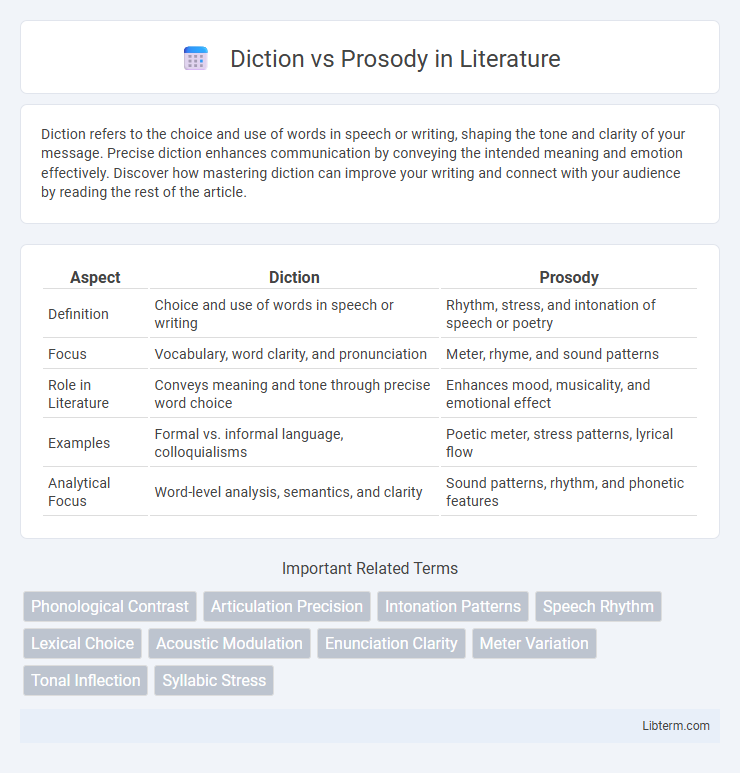Diction refers to the choice and use of words in speech or writing, shaping the tone and clarity of your message. Precise diction enhances communication by conveying the intended meaning and emotion effectively. Discover how mastering diction can improve your writing and connect with your audience by reading the rest of the article.
Table of Comparison
| Aspect | Diction | Prosody |
|---|---|---|
| Definition | Choice and use of words in speech or writing | Rhythm, stress, and intonation of speech or poetry |
| Focus | Vocabulary, word clarity, and pronunciation | Meter, rhyme, and sound patterns |
| Role in Literature | Conveys meaning and tone through precise word choice | Enhances mood, musicality, and emotional effect |
| Examples | Formal vs. informal language, colloquialisms | Poetic meter, stress patterns, lyrical flow |
| Analytical Focus | Word-level analysis, semantics, and clarity | Sound patterns, rhythm, and phonetic features |
Understanding Diction: Definition and Importance
Diction refers to the choice and clarity of words in speech or writing, playing a crucial role in conveying precise meaning and evoking specific emotions. Clear diction enhances communication effectiveness by ensuring the audience accurately receives the intended message. Understanding diction involves recognizing word selection's impact on tone, style, and audience engagement, making it fundamental in both literary analysis and effective verbal expression.
Unpacking Prosody: What It Entails
Prosody encompasses the patterns of rhythm, stress, and intonation in speech that convey meaning beyond the literal words, influencing emotional tone and listener perception. It involves elements such as pitch variation, tempo, loudness, and pauses that shape the natural flow and expressiveness of spoken language. Understanding prosody is essential for effective communication, as it enhances clarity, emphasizes key ideas, and evokes specific responses from the audience.
Key Differences Between Diction and Prosody
Diction refers to the choice and clarity of words and pronunciation in speech or writing, emphasizing phonetic precision and vocabulary selection. Prosody encompasses the rhythm, intonation, and stress patterns that shape the emotional tone and flow of spoken language. Key differences lie in diction focusing on the articulation of individual words, while prosody involves the melodic and temporal aspects that influence overall speech cadence.
The Role of Diction in Effective Communication
Diction plays a crucial role in effective communication by ensuring clarity and precision in word choice, which directly influences how messages are perceived and understood. Accurate diction enhances the speaker's credibility and helps convey emotions and intentions more convincingly. Mastery of diction improves audience engagement, making the overall communication more impactful.
Prosody’s Function in Conveying Emotion
Prosody, encompassing variations in pitch, rhythm, and stress, plays a crucial role in conveying emotion by providing auditory cues that shape the listener's emotional interpretation. Unlike diction, which focuses on the precise choice and pronunciation of words, prosody modulates how those words are delivered, influencing tone, mood, and intensity. Effective use of prosody enhances communication by adding emotional depth and nuance beyond the literal meaning of the text.
How Diction Affects Tone and Meaning
Diction directly influences tone and meaning by shaping the choice and clarity of words in speech or writing, which determines how a message is perceived emotionally and intellectually. Precise diction enhances understanding and conveys nuanced emotions, while vague or inappropriate word choices can obscure intent and alter the intended tone. The interaction between diction and tone is crucial for effective communication, as it guides the listener or reader's interpretation and response to the content.
Prosody and Its Influence on Speech Rhythm
Prosody, encompassing intonation, stress, and rhythm patterns, significantly shapes the natural flow and emotional tone of speech, enhancing listener engagement and comprehension. Variations in pitch, duration, and amplitude within prosody create distinctive rhythmic structures that guide the listener's attention and convey nuanced meanings beyond the lexical content. Unlike diction, which focuses on the clarity and articulation of words, prosody controls the speech melody and timing, fundamentally influencing the overall rhythm and expressive quality of spoken language.
Diction vs Prosody in Public Speaking
Diction in public speaking involves the clear pronunciation and choice of words to ensure the audience understands the message, while prosody refers to the rhythm, intonation, and stress patterns that convey emotion and emphasis. Effective diction ensures clarity, but without proper prosody, speech can sound monotonous and fail to engage listeners. Mastering both diction and prosody is essential for impactful communication and audience retention.
Improving Communication: Balancing Diction and Prosody
Balancing diction and prosody enhances communication by ensuring clarity of individual words and the natural rhythm of speech, which together improve listener comprehension and engagement. Precise diction promotes accurate pronunciation and enunciation, while effective prosody incorporates intonation, stress, and tempo to convey emotion and emphasize meaning. Mastering both elements allows speakers to deliver messages more powerfully and persuasively across various contexts.
Common Misconceptions About Diction and Prosody
Common misconceptions about diction and prosody often confuse diction solely with pronunciation, overlooking its broader role in word choice and clarity. Prosody is frequently misunderstood as just pitch variation, when it actually encompasses rhythm, stress, and intonation that shape meaning and emotional tone. Clarifying these distinctions enhances effective communication and nuanced speech interpretation.
Diction Infographic

 libterm.com
libterm.com